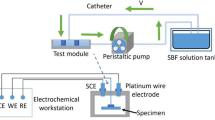Abstract
Magnesium alloys have been considered as promising biomedical materials and were studied in different physiological environments. In this work, corrosion behavior of AZ91D magnesium alloy in artificial saliva, simulated body fluid (SBF), and 3.5 wt.% NaCl solution was investigated using electrochemical techniques and a short-term immersion test. In contrast with other physiological environments, the amount of aggressive ions in artificial saliva is small. In addition, a protective film is formed on the surface of samples in artificial saliva. Experimental results suggest that corrosion resistance of AZ91D magnesium alloy in artificial saliva is better than that in c-SBF and 3.5 wt.% NaCl solution.






Similar content being viewed by others

References
Q. Miao, L.X. Hu, G.J. Wang, and E.D. Wang, Fabrication of Excellent Mechanical Properties AZ31 Magnesium Alloy Sheets by Conventional Rolling and Subsequent Annealing, Mater. Sci. Eng., A, 2011, 528, p 6694–6701
M.B. Kannan and R.K. Raman, In Vitro Degradation and Mechanical Integrity of Calcium-Containing Magnesium Alloys in Modified-Simulated Body Fluid, Biomaterials, 2008, 29, p 2306–2314
M.P. Staiger, A.M. Pietak, J. Huadmai, and G. Dias, Magnesium and Its Alloys as Orthopedic Biomaterials: A Review, Biomaterials, 2006, 27, p 1728–1734
C.E. Wen, M. Mabuchi, Y. Yamada, K. Shimojima, Y. Chino, and T. Asahina, Processing of Biocompatible Porous Ti and Mg, Scr. Mater., 2001, 45, p 1147–1153
N.E.L. Saris, E. Mervaala, H. Karppanen, J.A. Khawaja, and A. Lewenstam, Magnesium: An Update on Physiological, Clinical and Analytical Aspects, Clin. Chim. Acta, 2000, 294, p 1–26
J.P. Knochel, Disorders of Magnesium Metabolism, Harrisons Principles of Internal Medicine, McGraw-Hill, New York, 1998, p 2263-2265
A. Mauskop and B.M. Altura, Role of Magnesium in the Pathogenesis and Treatment of Migraines, Clin. Neurosci., 1998, 5, p 24–27
T.L.P. Slottow, R. Pakala, T. Okabe, D. Hellinga, R.J. Lovec, R. Waksman et al., Optical Coherence Tomography and Intravascular Ultrasound Imaging of Bioabsorbable Magnesium Stent Degradation in Porcine Coronary Arteries, Cardiovasc. Revascularization Med., 2008, 9, p 248–254
A. Repici and G. Rando, Stent for nonmalignant leaks, perforations, and ruptures, Tech. Gastrointest. Endosc., 2010, 12, p 237–245
J.M. Seitz, R. Eifle, J. Stahl, M. Kietzmann, and Fr.W. Bach, Characterization of MgNd2 alloy for potential applications in bioresorbable implantable devices, Acta Biomater., 2012, 8, p 3852–3864
T. Itoi, T. Inazawa, Y. Kuroda, M. Yamasaki, Y. Kawamura, and M. Hirohashi, Tensile Property and Cold Formability of a Mg96Zn2Y2 Alloy Sheet with a Long-Period Ordered Phase, Mater. Lett., 2010, 64, p 2277–2280
J. Kuhlmann, I. Bartsch, E. Willbold, S. Schuchardt, O. Holz, N. Hort, D. Höche, et al., Fast Escape of Hydrogen from Gas Cavities Around Corroding Magnesium Implants. Acta Biomater., 2012, doi:10.1016/j.actbio.2012.10.008
L. Choudhary and R.K. Raman, Magnesium Alloys as Body Implants: Fracture Mechanism Under Dynamic and Static Loadings in a Physiological Environment, Acta Biomater., 2012, 8, p 916–923
W. Wu, D. Gastaldi, K. Yang, L.L. Tan, L. Petrini, and F. Migliavacca, Finite Element Analyses for Design Evaluation of Biodegradable Magnesium Alloy Stents in Arterial Vessels, Mater. Sci. Eng., B, 2011, 176, p 1733–1740
P. Lu, H.N. Fan, Y. Liu, L. Cao, X.F. Wu, and X.H. Xu, Controllable Biodegradability, Drug Release Behavior and Hemocompatibility of PTX-Eluting Magnesium Stents, Colloids Surf. B, 2011, 83, p 23–28
Y. Xin, T. Hu, and P.K. Chu, Degradation Behavior of Pure Magnesium in Simulated Body Fluids with Different Concentrations of HCO3 −, Corros. Sci., 2011, 53, p 1522–1528
S. Hiromoto and M. Tomozawa, Hydroxyapatite Coating of AZ31 Magnesium Alloy by a Solution Treatment and its Corrosion Behavior in NaCl Solution, Surf. Coat. Technol., 2011, 205, p 4711–4719
C. Lin and S. Yen, Biomimetic Growth of Apatite on Electrolytic TiO2 Coatings in Simulated Body Fluid, Mater. Sci. Eng., C, 2006, 26, p 54–64
T. Kokubo and H. Takadama, How Useful is SBF in Predicting In Vivo Bone Bioactivity?, Biomaterials, 2006, 27, p 2907–2915
R. Rettig and S. Virtanen, Composition of Corrosion Layers on a Magnesium Rare-Earth Alloy in Simulated Body Fluids, J. Biomed. Mater. Res., 2009, 88A, p 359–369
H.F. Zhang, M. Liu, H.S. Fan, and X.D. Zhang, An Efficient Method to Synthesize Carbonated Nano Hydroxyapatite Assisted by Poly(ethylene glycol), Mater. Lett., 2012, 75, p 26–28
Y. Xin, K. Huo, H. Tao, G. Tang, and P.K. Chu, Influence of Aggressive Ions on the Degradation Behavior of Biomedical Magnesium Alloy in Physiological Environment, Acta Biomater., 2008, 4, p 2008–2015
J. Weng, Q. Liu, J.G.C. Wolke, X. Zhang, and K.D. Groot, Formation and Characteristics of the Apatite Layer on Plasma-Sprayed Hydroxyapatite Coatings in Simulated Body Fluid, Biomaterials, 1997, 18, p 1027–1035
G. Baril and N. Pebere, The Corrosion of Pure Magnesium in Aerated and Deaerated Sodium Sulphate Solutions, Corros. Sci., 2001, 43, p 471–484
F. Zucchi, V. Grassi, A. Frignani, C. Monticelli, and G. Trabanelli, Electrochemical Behavior of a Magnesium Alloy Containing Rare Earth Elements, J. Appl. Electrochem., 2006, 36, p 195–204
S. Jin, S. Amira, and E. Ghali, Electrochemical Impedance Spectroscopy Evaluation of the Corrosion Behavior of Die Cast and Thixocast AXJ530 Magnesium Alloy in Chloride Solution, Adv. Eng. Mater., 2007, 9, p 75–83
G. Socol, P. Torricelli, B. Bracci, M. Lliescu, F. Miroiu, A. Bigi et al., Biocompatible Nanocrystalline Octacalcium Phosphate Thin Films Obtained by Pulsed Laser Deposition, Biomaterials, 2004, 25, p 2539–2545
G.L. Song and A. Atrens, Understanding Magnesium Corrosion: A Framework for Improved Alloy Performance, Adv. Eng. Mater., 2003, 5, p 837–858
ASM Handbook, Volume 13A, Corrosion: Fundamentals, Testing and Protection. ASM International, Materials Park, 2003
Acknowledgment
This study was supported by the Fundamental Research Funds for the Central Universities (XDJK2011C069)
Author information
Authors and Affiliations
Corresponding author
Rights and permissions
About this article
Cite this article
Zhou, J., Li, Q., Zhang, H. et al. Corrosion Behavior of AZ91D Magnesium Alloy in Three Different Physiological Environments. J. of Materi Eng and Perform 23, 181–186 (2014). https://doi.org/10.1007/s11665-013-0751-4
Received:
Revised:
Published:
Issue Date:
DOI: https://doi.org/10.1007/s11665-013-0751-4



